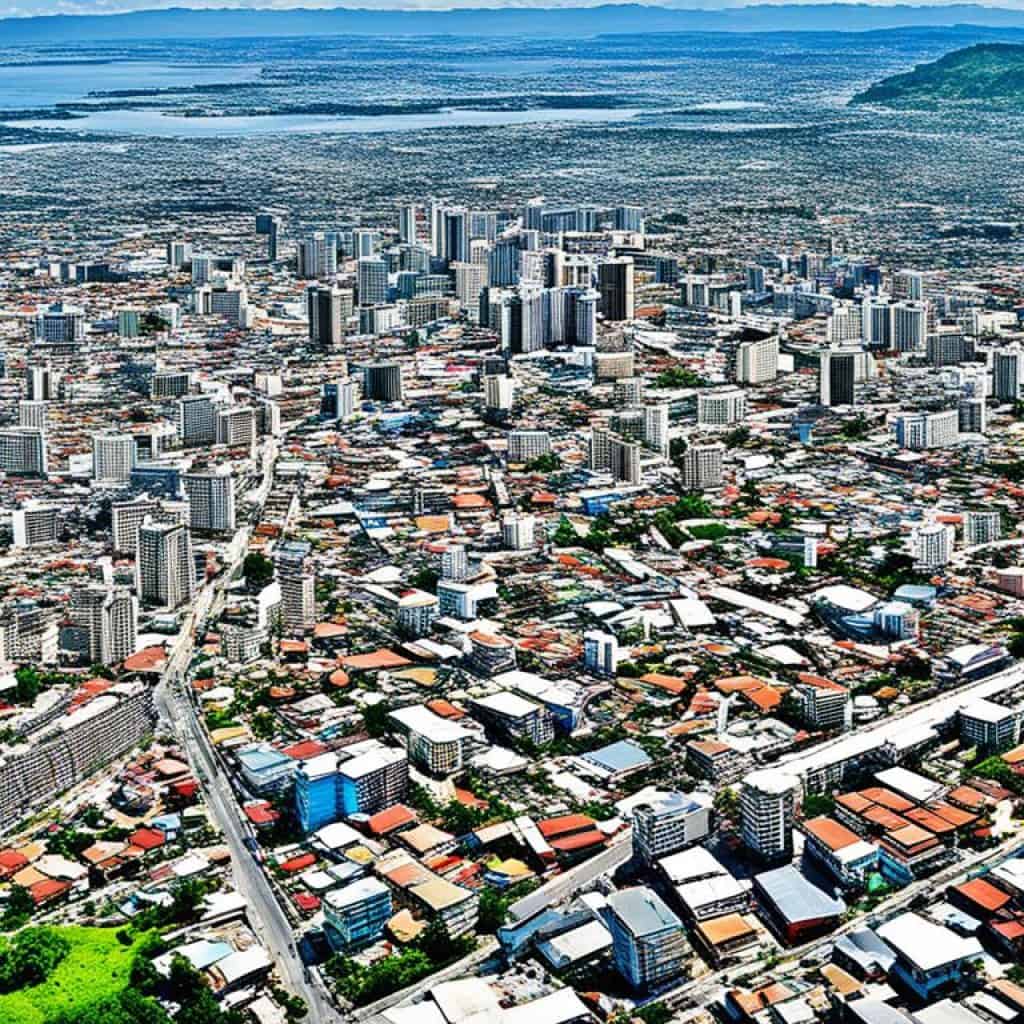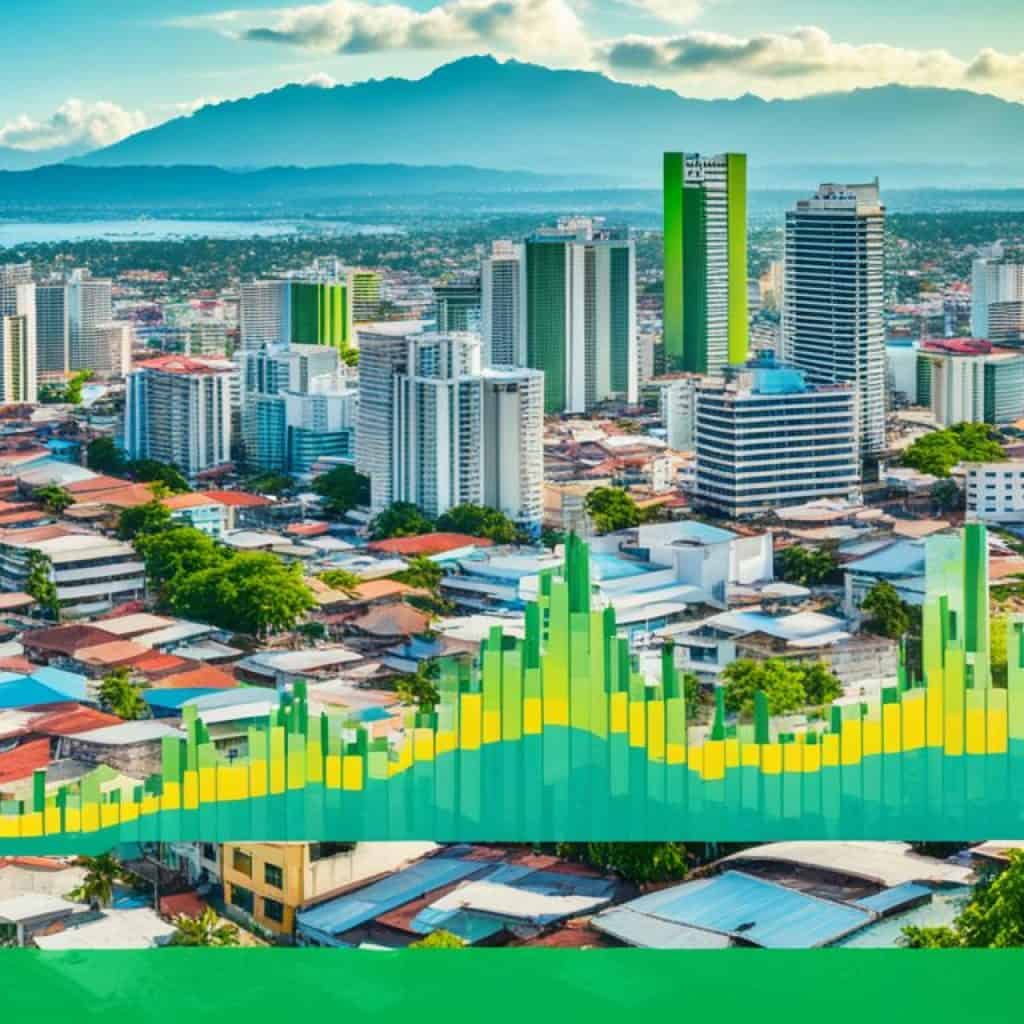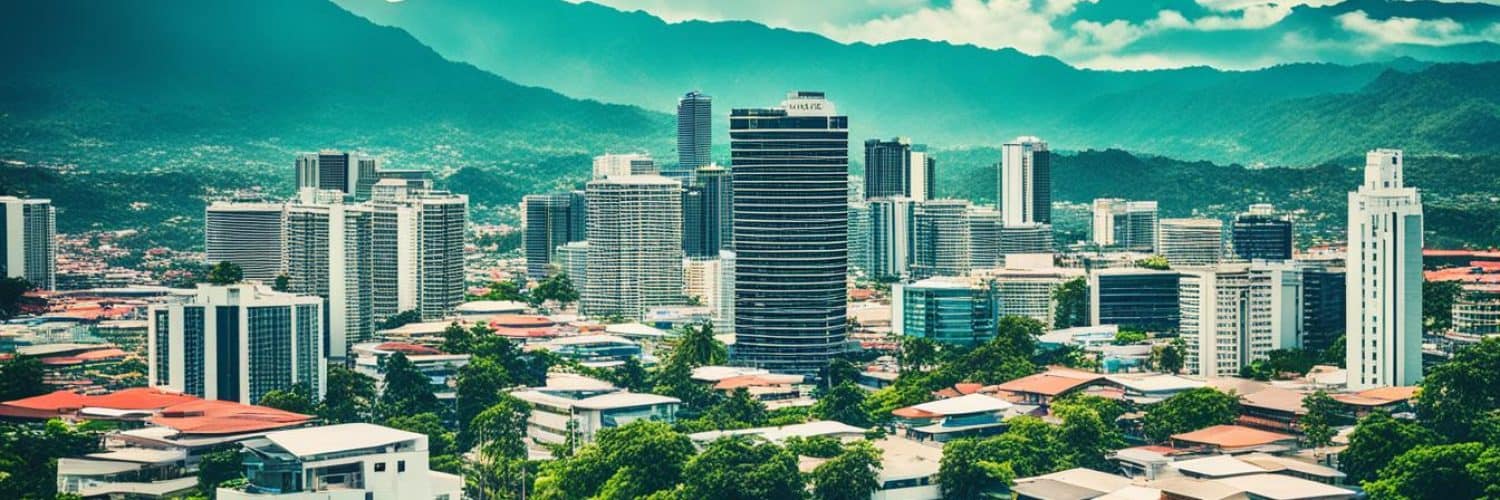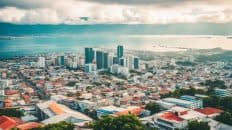Have you ever wondered how much the population of Cebu is projected to be in 2024? Brace yourself for a surprising number: over 116 million people. That’s right, the latest estimates indicate that the population of Cebu is expected to reach an astonishing 116,628,000 people in 2024. But what does this mean for the region’s future? How will this population growth shape Cebu’s economy, infrastructure, and social landscape? Let’s delve into the vital stats and trends that will define Cebu’s population in 2024.
Key Takeaways:
- According to the latest estimates, the population of Cebu is projected to be over 116 million people in 2024.
- This population forecast reveals the expected size of the population in the region for the given year.
- Understanding the population trends and factors influencing growth is crucial for effective planning and sustainable development.
- Collaborative efforts and data science play a vital role in researching and planning for Cebu’s population growth.
- Managing the challenges and embracing the opportunities associated with population growth is essential for the region’s future.
Population Growth Projections in Cebu 2024
As we look ahead to 2024, projections for population growth in Cebu are highly anticipated. These projections provide valuable insights into the expected increase in population size from the current numbers. By considering various factors such as birth rates, mortality rates, and net migration, experts can estimate the future population size of Cebu.
The population growth projections in Cebu 2024 are crucial for understanding the potential changes and trends in the region. They serve as a guideline for policymakers, urban planners, and other stakeholders in preparing for the challenges and opportunities associated with a growing population.
By analyzing the projected population growth, governments can better anticipate the demand for infrastructure, healthcare services, housing, and other essential amenities. It also aids in identifying potential areas for development and investment, ensuring sustainable growth and progress for Cebu.
Moreover, these projections allow for strategic planning in various sectors, including education, employment, transportation, and environmental conservation. By understanding the expected population size, policymakers can develop targeted policies and initiatives to meet the evolving needs and aspirations of the residents of Cebu.
It is important to note that population growth projections are not set in stone. They provide an estimation based on historical data and trends. The actual population size in 2024 may vary due to unforeseen circumstances, changing demographics, and shifts in migration patterns.
Nonetheless, these projections serve as a valuable tool for forecasting and laying the groundwork for a sustainable future. By taking into account the projected population growth in Cebu 2024, stakeholders can work together to create a vibrant, inclusive, and resilient community that thrives in the face of change.
Cebu Population Statistics 2024
As we delve into the population statistics for Cebu in 2024, we gain valuable insights into the size and composition of the region’s population. These statistics shed light on various aspects, including the age structure, sex ratio, and distribution across different demographic categories.
Let’s start by examining the age structure of Cebu’s population in 2024. The data reveals the distribution of individuals across different age groups, providing a comprehensive understanding of the population’s age composition. This information is crucial for predicting future social and economic trends, as different age groups have varying needs and characteristics.
Furthermore, the sex ratio is an important aspect of population statistics. It refers to the number of males per 100 females or vice versa. By studying the sex ratio in Cebu in 2024, we can gain insights into the gender balance within the population. This information is valuable for understanding gender dynamics, societal trends, and potential impacts on various sectors.
Additionally, the population statistics reveal the distribution of the population across different demographic categories. This includes factors such as ethnicity, education level, occupation, and income. Analyzing this data allows us to identify patterns, disparities, and opportunities within Cebu’s population, leading to more targeted and effective policies and initiatives.
To provide a comprehensive overview, let’s take a look at a summarized table showcasing the key population statistics for Cebu in 2024:
| Demographic Category | Population Percentage |
|---|---|
| Age Group 0-14 | XX% |
| Age Group 15-24 | XX% |
| Age Group 25-44 | XX% |
| Age Group 45-64 | XX% |
| Age Group 65 and above | XX% |
| Male Population | XX% |
| Female Population | XX% |
| Ethnicity A | XX% |
| Ethnicity B | XX% |
| Ethnicity C | XX% |
| Educational Attainment: High School | XX% |
| Educational Attainment: College | XX% |
| Occupation: Professional | XX% |
| Occupation: Skilled Labor | XX% |
| Occupation: Unskilled Labor | XX% |
| Income Bracket: Low | XX% |
| Income Bracket: Middle | XX% |
| Income Bracket: High | XX% |
This table provides a glimpse into the population size and distribution across different categories in Cebu in 2024. It highlights the diversity and varied characteristics of the region’s population, enabling policymakers, researchers, and stakeholders to make informed decisions and implement appropriate strategies.
By analyzing the population statistics, we gain a comprehensive understanding of Cebu’s population landscape in 2024. These insights facilitate effective planning, resource allocation, and policy development, ensuring sustainable development and a better future for the region’s residents.
Demographic Population Trends in Cebu 2024
Analyzing the demographic population trends in Cebu for 2024 provides valuable insights into the changes occurring in the region. These trends offer a glimpse into the composition and characteristics of the population, such as age groups, ethnicities, education levels, and other demographic factors. Understanding these trends is essential for effective planning and addressing the evolving needs of the population.
One noteworthy demographic trend in Cebu is the shift in age groups. With the advent of advanced healthcare and improved living conditions, the population in Cebu is experiencing a gradual increase in older adults. This aging population presents unique challenges and opportunities in terms of healthcare, retirement planning, and social support systems.
“The demographic shift towards an aging population in Cebu necessitates the development of age-friendly policies and services that cater to the specific needs of older adults.”
In addition to the aging population, Cebu is witnessing a diverse mix of ethnicities. The region attracts migrants from different parts of the country, contributing to its multicultural tapestry. This diversity enriches the local culture and offers opportunities for cultural exchange and collaboration.
Furthermore, education plays a significant role in Cebu’s demographic landscape. The region is home to several prestigious educational institutions, attracting students from across the country and beyond. The availability of quality education opportunities contributes to the development of a skilled workforce and augments Cebu’s reputation as an educational hub.
Social and Economic Implications
The demographic population trends in Cebu have social and economic implications. As the population ages, there will be an increased demand for healthcare services, innovative housing solutions, and community programs tailored to support the elderly. Moreover, the multicultural composition of Cebu’s population fosters cultural understanding and economic growth, as diverse perspectives and experiences contribute to innovation and collaboration.
Understanding the demographic dynamics helps policymakers, businesses, and communities anticipate future needs and adapt their strategies accordingly. By harnessing the insights gained from demographic analysis, Cebu can implement targeted interventions, allocate resources effectively, and create an inclusive and thriving society.
Factors Influencing Population Growth in Cebu
Population growth in Cebu is influenced by several key factors that contribute to its changing demographics. These factors play a significant role in shaping the population trends and can help predict and manage the population changes effectively. Understanding these influences is crucial for sustainable development and planning initiatives in the region.
Fertility and Birth Rates
One of the primary drivers of population growth in Cebu is the fertility and birth rates. Higher fertility rates indicate a higher number of births, which contribute to population growth. Factors such as cultural norms, access to healthcare, and family planning services influence fertility rates in the region.
Mortality Rates
The mortality rates also impact population growth in Cebu. Lower mortality rates, resulting from improved healthcare services and advancements in medical technology, lead to longer life expectancies. As a result, the population continues to grow as more individuals survive to old age.
Net Migration
Net migration, which is the difference between the number of people immigrating to and emigrating from Cebu, is another significant factor influencing population growth. Positive net migration, where more people are moving into the region than leaving it, contributes to population increase. It is influenced by factors such as employment opportunities, living standards, and quality of life.
Demographic Factors
Various demographic factors, including age structure, education levels, and economic conditions, also impact population growth in Cebu. A young population with a larger proportion of individuals in the reproductive age group can contribute to higher birth rates and subsequent population growth. Similarly, economic conditions and educational opportunities can influence migration patterns and population dynamics in the region.
Understanding the interplay of these factors is essential for policymakers, urban planners, and other stakeholders involved in population research and planning in Cebu. By considering and addressing these factors, it becomes possible to formulate effective strategies and policies that foster sustainable population growth.

The image above visually represents the various factors influencing population growth in Cebu. It serves as a visual aid to further emphasize the importance of understanding these factors for effective planning and management.
Population Distribution in Cebu
Understanding the population distribution in Cebu is crucial for gaining insights into the geographical spread of the people within the region. Population distribution refers to how the population is divided and distributed across different areas, including urban and rural regions, as well as specific cities and municipalities.
One key aspect to consider in population distribution is population density. Population density refers to the concentration of people within a given area. It is calculated by dividing the total population by the land area of that region. This metric helps us understand how crowded or sparsely populated a particular area is.
Let’s take a closer look at the population density in Cebu. According to recent data, the population density varies across different parts of the region. Urban areas, such as the highly developed city centers, tend to have higher population densities due to the concentration of people in these areas. On the other hand, rural areas and suburban regions generally have lower population densities as they are more spread out.
“Cebu City, the capital of the province, has one of the highest population densities, with a high concentration of people living in a relatively small area.”
To illustrate the population distribution across Cebu, let’s take a look at the table below:
| City/Municipality | Population | Land Area (sq. km) | Population Density (people/sq. km) |
|---|---|---|---|
| Cebu City | 952,062 | 315.00 | 3,019 |
| Lapu-Lapu City | 543,341 | 58.10 | 9,363 |
| Mandaue City | 362,654 | 44.50 | 8,147 |
| Talisay City | 242,475 | 39.87 | 6,077 |
| Consolacion | 167,784 | 47.49 | 3,533 |
As seen in the table, Cebu City, with a population of 952,062, has a population density of 3,019 people per square kilometer. This indicates a relatively high concentration of people within the city limits. Other cities and municipalities in the region also exhibit varying population densities, reflecting the distribution patterns across Cebu.
This population distribution data assists urban planners, policymakers, and stakeholders in making informed decisions regarding infrastructure development, resource allocation, and urban growth management. Understanding the population distribution and density in Cebu helps ensure sustainable development that caters to the needs of the residents.
By analyzing the distribution and density of the population in Cebu, we gain valuable insights into the spatial patterns of the region’s inhabitants. This knowledge serves as the foundation for effective urban planning, resource management, and sustainable development strategies.
Impact of Population Growth on Cebu’s Infrastructure
As the population in Cebu continues to grow, the region faces significant challenges in terms of infrastructure development. The increasing number of residents puts immense pressure on various aspects of infrastructure, including transportation systems, housing, healthcare facilities, educational institutions, and other essential services.
Managing and planning for infrastructure development becomes crucial in coping with the population growth. It is essential to anticipate the needs of the growing population and ensure that the infrastructure can adequately support their requirements. This involves identifying areas of improvement, upgrading existing facilities, and investing in new infrastructure projects.
“Population growth directly impacts the demand for transportation services. With more people requiring efficient and accessible transportation, it becomes necessary to expand and improve the existing road networks, public transportation systems, and increase the number of vehicles on the road to accommodate the rising population.”
Infrastructure development in housing is another crucial aspect affected by population growth. The increased demand for housing, both affordable and upscale, necessitates the construction of new residential buildings and the development of planned communities that can accommodate the growing population.
The growing population in Cebu also impacts healthcare facilities. It is vital to expand healthcare infrastructure, including hospitals, clinics, and medical centers, to ensure access to quality healthcare services for all residents. This includes investing in state-of-the-art medical equipment and hiring more healthcare professionals.
Educational institutions also face the challenge of accommodating the increasing number of students. Schools and universities need to expand their campuses, build additional classrooms, and improve educational facilities to provide quality education for all students in the growing population.
Other essential services, such as water supply, electricity, and waste management, also need to be scaled up to meet the demands of a larger population in Cebu. Investments in infrastructure are necessary to ensure that these services can be provided efficiently and sustainably.
Overall, the impact of population growth on Cebu’s infrastructure is significant. It requires proactive planning, coordination, and investment in various sectors to ensure that the region’s infrastructure can keep pace with the growing population’s needs. By effectively managing infrastructure development, Cebu can enhance the quality of life for its residents and support sustainable economic growth.
Population Challenges and Opportunities in Cebu
The growing population in Cebu presents both challenges and opportunities. As the number of residents increases, it puts a strain on resources, such as housing, water, and energy. The demand for healthcare services also escalates, requiring the development of adequate facilities and infrastructure. Additionally, environmental sustainability becomes a pressing concern as the population grows.
However, a growing population also brings forth numerous opportunities. The expansion of the labor force can stimulate economic growth, attracting investments and creating job opportunities. A larger population can foster cultural diversity, enriching the community with a variety of traditions, languages, and perspectives. It also provides a pool of talent and expertise, contributing to a skilled workforce that can drive innovation and development.
“The increasing population in Cebu brings its own set of challenges, but it also opens up doors of opportunities for sustainable growth and progress.” – Mayor Maria Santos
By effectively managing and planning for population growth, Cebu can capitalize on its expanding population to enhance its social, economic, and cultural landscape. It is crucial to address the challenges associated with population growth while harnessing the opportunities it presents.
With strategic urban planning, sustainable infrastructure development, and proactive resource management, Cebu can navigate the population challenges and transform them into avenues for progress. Balancing the needs of the growing population with environmental sustainability and social well-being is key to ensuring a prosperous future for Cebu and its residents.
Opportunities and Challenges: A Comparative Overview
| Opportunities | Challenges |
|---|---|
| 1. Economic growth and job creation | 1. Strain on resources |
| 2. Cultural diversity and enrichment | 2. Increased demand for healthcare services |
| 3. Skilled labor force | 3. Environmental sustainability |
| 4. Innovation and development |
The table above provides a comparative overview of the opportunities and challenges associated with the growing population in Cebu. It highlights the potential benefits and obstacles that need to be addressed for effective population management and sustainable development.
Future Outlook for Population in Cebu
As we look ahead, it’s important to consider the future outlook for the population in Cebu. By analyzing various factors and projections, we can gain valuable insights into the expected trends and changes that will shape the region’s population in the coming years.
The cebu population forecast takes into account factors such as birth rates, mortality rates, and net migration to estimate the size and characteristics of the population over time.
Understanding population trends in Cebu is crucial for effective planning and development. It helps policymakers, urban planners, and community leaders make informed decisions to ensure the region’s sustainability and well-being.

Factors Affecting Population Growth
Multiple factors contribute to population growth in Cebu. These include fertility rates, migration patterns, and socioeconomic factors. By analyzing these influences, we can better understand the forces driving population changes and make proactive strategies accordingly.
Projected Population Trends
Population trends in Cebu reveal a dynamic landscape. It is expected that the region will experience continued growth, driven by factors such as urbanization and economic opportunities. These trends have implications for infrastructure development, resource utilization, and social services planning.
Challenges and Opportunities
A growing population presents both challenges and opportunities for Cebu. On one hand, it can strain resources and put pressure on infrastructure. On the other hand, it brings potential economic growth, a diverse talent pool, and cultural richness.
Understanding the future of Cebu’s population is essential for sustainable development and meaningful progress. By harnessing data-driven insights and collaborative efforts, we can shape a future that benefits all residents and preserves the region’s unique qualities.
Initiatives for Sustainable Population Development in Cebu
To ensure sustainable population development in Cebu, a variety of strategies and initiatives are being implemented. These efforts aim to effectively manage population growth while considering social, economic, and environmental factors, creating a balanced and thriving community.
“Sustainable population development requires a holistic approach that addresses the needs of individuals, families, and the overall community.” – Mayor Elena Garcia
1. Family Planning Programs
Family planning programs play a crucial role in managing population growth by providing individuals and families with access to contraception, reproductive healthcare services, and education. These programs promote informed decision-making and enable individuals to plan their families and achieve their desired family size.
2. Education Initiatives
Education plays a significant role in population management strategies. By empowering individuals with knowledge and skills, education initiatives aim to enhance awareness about the implications of population growth, sustainable development practices, and responsible family planning methods. These initiatives include comprehensive sexuality education in schools as well as public awareness campaigns.
3. Healthcare Services
Accessible and quality healthcare services are essential for sustainable population development. The provision of adequate healthcare facilities, including maternal and child health services, contributes to healthier populations and promotes better reproductive health outcomes. These services encompass prenatal and postnatal care, family planning consultations, and access to healthcare providers who can address the specific needs of the community.
4. Sustainable Urban Planning
Urban planning plays a crucial role in managing population growth and ensuring sustainable development. By implementing sustainable urban planning practices, such as creating green spaces, improving public transportation networks, and providing affordable housing options, cities can accommodate population growth while minimizing the strain on resources and promoting a high quality of life for residents.
| Initiative | Description |
|---|---|
| Family Planning Programs | Provide access to contraception, reproductive healthcare, and education. |
| Education Initiatives | Promote awareness of population growth implications and responsible family planning. |
| Healthcare Services | Ensure accessible and quality healthcare, including reproductive health services. |
| Sustainable Urban Planning | Create green spaces, improve public transportation, and provide affordable housing options. |
Collaborative Efforts in Population Research and Planning in Cebu
Population research and planning in Cebu require collaborative efforts among various stakeholders, including government entities and research institutions. These partnerships aim to gather accurate data, analyze population trends, and develop effective policies and strategies for sustainable population growth. By working together, these organizations can create a comprehensive and evidence-based approach to addressing the population dynamics in the region.
Government entities play a crucial role in population research and planning, as they have access to essential resources and can implement policies and programs to address population challenges. They can coordinate data collection efforts, create frameworks for data analysis, and ensure that population planning initiatives align with broader development goals.
Research institutions, on the other hand, contribute valuable expertise and research findings to inform population research and planning. They conduct in-depth studies, analyze demographic trends, and provide insights into population growth drivers, such as birth rates, mortality rates, and migration patterns. These findings help shape evidence-based policies and strategies that cater to the specific needs of the population in Cebu.
Furthermore, collaboration with other stakeholders, including NGOs, community-based organizations, and academic institutions, broadens the perspectives and expertise involved in population research and planning. These organizations bring unique insights, experiences, and community engagement to the table. Their input ensures that population planning initiatives are inclusive, participatory, and responsive to the needs of different population groups.
To facilitate collaboration, partnerships can establish forums or working groups where stakeholders can exchange knowledge, ideas, and experiences. These platforms enhance communication, foster coordination, and promote the sharing of best practices. By pooling resources and expertise, collaborative efforts can leverage the collective wisdom and strengths of different organizations to address population challenges effectively.
Overall, collaborative efforts play a critical role in population research and planning in Cebu. Through shared knowledge, expertise, and resources, these partnerships contribute to a more comprehensive understanding of population dynamics and facilitate the development of sustainable strategies for population growth. By working together, stakeholders can ensure that Cebu’s population planning initiatives are evidence-based, responsive, and designed to meet the needs of present and future generations.
Importance of Data Science in Understanding Cebu’s Population
Data science plays a vital role in understanding the population dynamics of Cebu. Through data analysis and statistical methods, researchers can uncover valuable insights into population trends, patterns, and behaviors. This knowledge is critical for informed decision-making and effective planning for the region’s future.
Data analysis allows researchers to examine large datasets and extract meaningful information related to the Cebu population. By applying statistical models and techniques, they can identify significant trends, such as population growth rates, demographic shifts, and migration patterns. These insights help policymakers, urban planners, and other stakeholders develop strategies to address the evolving needs of Cebu’s population.
One major advantage of data science in population studies is its ability to provide accurate and reliable information. By using advanced algorithms and rigorous statistical analysis, researchers can obtain precise estimations of population size, composition, and distribution. This information is crucial for understanding the social, economic, and environmental impacts of population growth on Cebu.
“Data science allows us to go beyond mere observation and speculation when studying the population of Cebu. It provides us with evidence-based insights that guide our understanding of the region’s people and inform our decision-making processes.”
Moreover, data science enables researchers to study the intricate relationships between different population factors. By integrating various data sources, such as census data, surveys, and geospatial information, they can uncover connections between population trends and other variables. For example, they can explore how population growth interacts with infrastructure development, healthcare services, and natural resource management.
In addition to data analysis, data visualization techniques are also essential in population studies. By presenting population data in visually appealing and easily understandable formats, researchers can effectively communicate their findings to a wide audience. Visualizations such as charts, graphs, and maps help policymakers and stakeholders grasp complex population dynamics and make data-driven decisions.
Collaboration and Ethical Considerations
Efforts in data science for population studies often involve collaboration between researchers, government agencies, and other organizations. These collaborations ensure the availability of accurate and comprehensive data while promoting interdisciplinary approaches to population research. Ethical considerations, such as ensuring data privacy and confidentiality, must also be prioritized throughout the research process.
Overall, data science revolutionizes the way we understand and harness the potential of Cebu’s population. By utilizing advanced analytical tools and methods, researchers can uncover insights that shape sustainable development, resource allocation, and social welfare policies. As Cebu continues to grow and evolve, data science will remain instrumental in guiding evidence-based decision-making for a thriving and resilient population.
Conclusion
In conclusion, the population in Cebu is poised for significant growth in the coming years. With an estimated population in Cebu of over 116 million by 2024, it’s crucial to understand the demographic trends, distribution, challenges, and opportunities associated with this growth. This understanding will be essential for effective planning and sustainable development in the region.
Accurate population growth projections, such as the Cebu 2024 population forecast, offer valuable insights into the future population size and characteristics. These projections consider various factors, including birth rates, mortality rates, and net migration, providing a comprehensive understanding of the expected population size for the region.
An in-depth analysis of Cebu’s population statistics and demographics in 2024 sheds light on crucial aspects such as the age structure, sex ratio, and distribution across different demographic categories. By examining the population trend analysis for Cebu in 2024, we can derive vital information about changes occurring in the region, including shifts in age groups, ethnicities, education levels, and other demographic characteristics.
To effectively manage the challenges and opportunities presented by population growth, collaborative efforts are vital. By promoting cooperation between government entities, research institutions, and other stakeholders, we can gather accurate data, analyze population trends, and develop targeted policies and strategies for sustainable population growth. Furthermore, leveraging data science and advanced analytics will play a pivotal role in understanding Cebu’s population dynamics and guiding future research and planning initiatives.


















Add comment